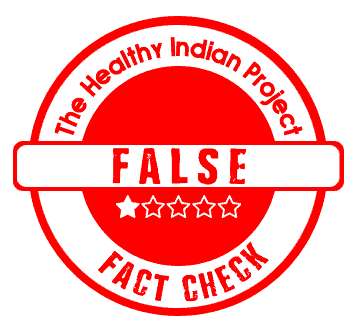Last Updated on November 20, 2023 by Shabnam Sengupta
Quick Take
A video on social media has made several serious claims and one of them is packaged atta contains maida. We fact checked and found the claim to be False.

The Claim
A Instagram account by the name deepakthakranfitness in one of his videos explain about the the lack of stringent regulations by the Food Safety and Standards Authority of India (FSSAI) primarily concentrating on labelling and basic data has created a situation where companies resort to cost-cutting by adulterating products with maida, adding preservatives and bleaching agents for prolonged shelf life. Some companies use inferior-quality grains, and during wheat cultivation, farmers may employ harmful chemicals like urea. Additionally, packaged atta is often not freshly ground, contrary to Ayurvedic principles that advocate consuming fresh produce.
Fact Check
Does the packaged atta contain maida?
No, if the packaged atta label states that it is made from 100% wheat atta, then it contains only pure wheat flour atta. If the consumer is buying mixed flour or multigrain atta, there are chances of different flours being used. The Food Safety and Standards Authority of India (FSSAI) has rules and regulations for packaged atta, and every packaged atta company must adhere to them to avoid potential penalties.

Food label consultant Kamran Khan says, “FSSAI has defined standards for different Wheat Flours such as “Whole Wheat Flour, Protein rich wheat flour, Refined Wheat Flour and Protein rich refined wheat flour. In a move to help consumers make an informed choice while buying packaged products, the Food Safety and Standards Authority of India (FSSAI) has asked food companies to label atta as ‘whole wheat flour’ and maida as ‘refined wheat flour’.” He also informed about a link where every consumer can look at it and get to know how FSSAI plans the whole wheat flour processing, which is not just not limited to label and packaging.
What is FSSAI and how it defines packaged atta?
The Food Safety and Standards Authority of India (FSSAI) was formed under the Food Safety and Standards Act of 2006, which unifies the management of food-related matters that were previously dispersed across different government bodies. FSSAI’s primary role is to establish scientifically grounded standards for food products and oversee their production, storage, distribution, sale, and import to guarantee the accessibility of safe and nutritious food for human consumption.
What is the shelf life of packaged atta?
The packaging of atta mentions a shelf life, which is typically around 3 months. This description is similar to the wheat atta used at home, assuring consumers of its purity and similarity to traditionally ground wheat flour. It offers convenience and the assurance of quality for everyday cooking needs.
Do we use fresh atta everyday at home?
No, fresh atta is not used daily in most homes. Instead, it is a common practice to store atta in a sealed container to ensure its preservation and convenience. This allows households to have a readily available supply of flour for daily cooking needs. Using stored atta is a practical approach to modern cooking, as it saves time and effort, providing a convenient and consistent source of flour for various culinary purposes. Storing atta appropriately helps maintain its quality over time and is a common practice in households across the world.
How to choose a 100% wheat atta without maida?
To ensure that you’re purchasing packaged atta that is primarily whole wheat and free from maida, here are some tips:
1. Read the Label: Examine the product label and description to check whether it’s labeled as “whole wheat atta” or “100% whole wheat.” These products are more likely to be maida-free.
2. Avoid Terms like ‘Multigrain’ or ‘Blended’: If you prefer purely whole wheat atta, it’s best to avoid products with terms like ‘multigrain’ or ‘blended’ on the label. These products may contain mixed grains, including refined flours.
3. Look for Recognized Brands: Opt for well-established and trusted brands, as they are more likely to offer quality whole wheat atta products.
4. Check the Ingredients: Some products list the ingredients on the packaging. Review this section to see if there’s any mention of maida or refined flour. Ideally, it should only list whole wheat flour.
Is the use of urea a common practice among all farmers engaged in the cultivation of packaged food?
The use of urea whether it is neem coated urea or normal is a common practice among all farmers engaged in the cultivation of food crops. Urea is primarily a source of nitrogen fertiliser used to enhance crop growth. Its usage depends on various factors, including crop type, soil conditions, and local agricultural practices. Organic farming, for instance, may avoid synthetic fertilisers like urea. Each farmer’s approach to cultivation varies, and the use of urea is not universal in packaged food production.
Can every Indian afford organic fruits and vegetables?
Not everyone in India can afford organic fruits and vegetables. Organic produce is typically more expensive than conventionally grown fruits and vegetables due to the higher costs associated with organic farming practices. As a result, it tends to be a choice for those with higher disposable incomes. While the demand for organic food is growing in India, accessibility and affordability are challenges for many, making it less accessible to the broader population, particularly in rural areas or for those on limited budgets.
How does lack of knowledge cause harm to society?
The lack of knowledge can indeed have detrimental consequences for society, particularly in the age of rampant misinformation. In today’s world, where billions people use social media, the spread of false information poses a significant threat. Case in point, there have been instances of people confusing gluten with plastic in packaged atta. Similarly, unqualified social media influencers, often under the guise of promoting Ayurveda, can manipulate consumers’ beliefs. Packaged atta, which undergoes proper processing and hygiene measures, is often equivalent to traditionally ground flour. The lack of knowledge can thus lead to baseless fears and misconceptions that harm society.
Disclaimer: Medical Science is an ever evolving field. We strive to keep this page updated. In case you notice any discrepancy in the content, please inform us at [email protected]. You can futher read our Correction Policy here. Never disregard professional medical advice or delay seeking medical treatment because of something you have read on or accessed through this website or it's social media channels. Read our Full Disclaimer Here for further information.

